Verlag Dohr is a publishing house for music in Bergheim, North Rhine-Westphalia, Germany.
It was founded in 1990 by Christoph Dohr in Bickendorf , which moved to Rheinkassel in 1992 and to Haus Eller in Bergheim in 2010. It publishes a quarterly magazine of music, fermate, sheet music mostly of composers of the 20th century but also works of the 19th and 18th century in critical editions, books and recordings. The publisher provides around 100 new editions per year. It received prizes such as the Deutscher Musikeditionspreis for the edition of Robert Schumann's letters.
Dohr runs in Haus Eller also a museum of historic keyboard instruments. They are presented to the public in concerts and often used for recordings. The museum also contains a library focused on topics such as pianos, keyboard instruments and pianists.

The clavichord is a stringed rectangular keyboard instrument that was used largely in the Late Middle Ages, through the Renaissance, Baroque and Classical eras. Historically, it was mostly used as a practice instrument and as an aid to composition, not being loud enough for larger performances. The clavichord produces sound by striking brass or iron strings with small metal blades called tangents. Vibrations are transmitted through the bridge(s) to the soundboard.
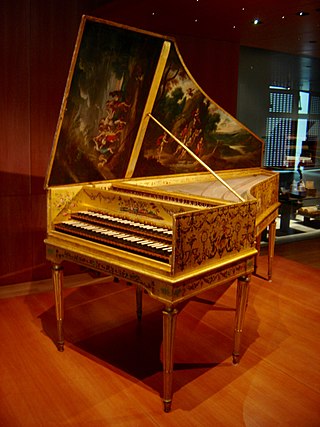
A harpsichord is a musical instrument played by means of a keyboard. This activates a row of levers that turn a trigger mechanism that plucks one or more strings with a small plectrum made from quill or plastic. The strings are under tension on a soundboard, which is mounted in a wooden case; the soundboard amplifies the vibrations from the strings so that the listeners can hear it. Like a pipe organ, a harpsichord may have more than one keyboard manual, and even a pedal board. Harpsichords may also have stop buttons which add or remove additional octaves. Some harpsichords may have a buff stop, which brings a strip of buff leather or other material in contact with the strings, muting their sound to simulate the sound of a plucked lute.
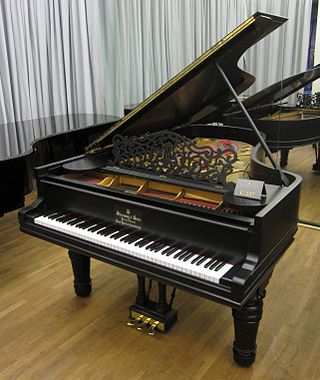
The piano is a keyboard instrument that produces sound when pressed on the keys. Most modern pianos have a row of 88 black and white keys: 52 white keys for the notes of the C major scale and 36 shorter black keys raised above the white keys and set further back, for sharps and flats. This means that the piano can play 88 different pitches, spanning a range of a bit over seven octaves. The black keys are for the "accidentals", which are needed to play in all twelve keys.

Sonata, in music, literally means a piece played as opposed to a cantata, a piece sung. The term evolved through the history of music, designating a variety of forms until the Classical era, when it took on increasing importance. Sonata is a vague term, with varying meanings depending on the context and time period. By the early 19th century, it came to represent a principle of composing large-scale works. It was applied to most instrumental genres and regarded—alongside the fugue—as one of two fundamental methods of organizing, interpreting and analyzing concert music. Though the musical style of sonatas has changed since the Classical era, most 20th- and 21st-century sonatas still maintain the same structure.

A keyboard instrument is a musical instrument played using a keyboard, a row of levers that are pressed by the fingers. The most common of these are the piano, organ, and various electronic keyboards, including synthesizers and digital pianos. Other keyboard instruments include celestas, which are struck idiophones operated by a keyboard, and carillons, which are usually housed in bell towers or belfries of churches or municipal buildings.

Carl Philipp Emanuel Bach, also formerly spelled Karl Philipp Emmanuel Bach, and commonly abbreviated C. P. E. Bach, was a German Classical period composer and musician, the fifth child and second surviving son of Johann Sebastian Bach and Maria Barbara Bach.
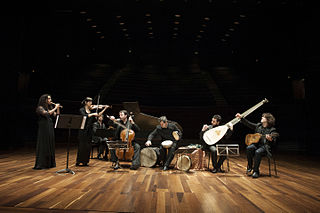
Historically informed performance is an approach to the performance of classical music, which aims to be faithful to the approach, manner and style of the musical era in which a work was originally conceived.
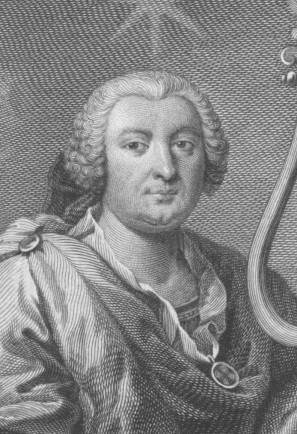
José António Carlos de Seixas was a pre-eminent Portuguese composer of the 18th century. An accomplished virtuoso of both the organ and the harpsichord, Seixas succeeded his father as the organist for Coimbra Cathedral at the age of fourteen. In 1720, he departed for the capital, Lisbon, where he was to serve as the organist for the royal chapel, one of the highest offices for a musician in Portugal, a position which earned him a knighthood. Much of Seixas' music rests in an ambiguous transitional period from the learned style of the 17th century to the galant style of the 18th century.

The viola organista is a musical instrument designed by Leonardo da Vinci. It uses a friction belt to vibrate individual strings, with the strings selected by pressing keys on a keyboard. Leonardo's design has intrigued instrument makers for more than 400 years, but though similar instruments have been built, no extant instrument constructed directly from Leonardo's incomplete designs is known. Sometimes it is mistakenly referred to as the harpsichord viola, which is a different instrument.

The pump organ is a type of free-reed organ that generates sound as air flows past a vibrating piece of thin metal in a frame. The piece of metal is called a reed. Specific types of pump organ include the reed organ, harmonium, and melodeon. The idea for the free reed was imported from China through Russia after 1750, and the first Western free-reed instrument was made in 1780 in Denmark.
In music, fingering, or on stringed instruments sometimes also called stopping, is the choice of which fingers and hand positions to use when playing certain musical instruments. Fingering typically changes throughout a piece; the challenge of choosing good fingering for a piece is to make the hand movements as comfortable as possible without changing hand position too often. A fingering can be the result of the working process of the composer, who puts it into the manuscript, an editor, who adds it into the printed score, or the performer, who puts his or her own fingering in the score or in performance.
Fingering...also stopping...(1) A system of symbols for the fingers of the hand used to associate specific notes with specific fingers....(2)Control of finger movements and position to achieve physiological efficiency, acoustical accuracy [frequency and amplitude] and musical articulation.
The luthéal is a kind of hybrid piano which extended the "register" possibilities of a piano by producing cimbalom-like sounds in some registers, exploiting harmonics of the strings when pulling other register-stops, and also some registers making other objects, which were lowered just above the strings, resound. The instrument became obsolete partly because most of its mechanics were too sensitive, needing constant adjustment. The only pieces in the general repertoire to feature the luthéal are L'enfant et les sortilèges (1920–25) and Tzigane (1924), by Maurice Ravel.
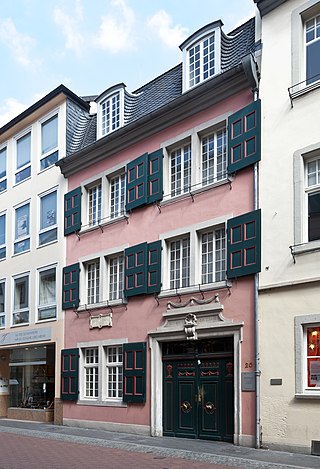
The Beethoven House in Bonn, Germany, is a memorial site, museum, and cultural institution serving various purposes. Founded in 1889 by the Beethoven-Haus association, it studies the life and work of composer Ludwig van Beethoven.

Music technology is the study or the use of any device, mechanism, machine or tool by a musician or composer to make or perform music; to compose, notate, playback or record songs or pieces; or to analyze or edit music.
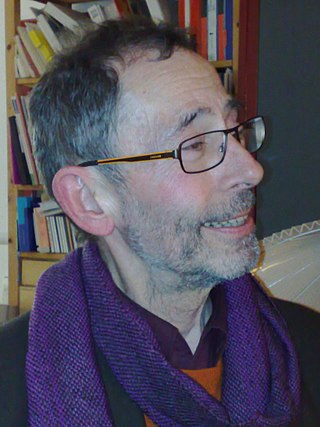
Bernd Wiesemann was a German pianist, composer, music educator and conceptual artist.
The Antunes family were Portuguese harpsichord- and early piano builders in the 18th and 19th centuries.
Hatto Ständer was a German church musician, academic, concert organist and composer. He was a professor of organ and choral conducting at the Dortmund University for three decades, and director of its department Catholic church music. His compositions are mostly sacred music, but he also wrote piano music and chamber music. He served as an advisor to organ builders for notable organs in Dortmund.
Thomas Synofzik is a German musicologist. He is director of the Robert Schumann House in Zwickau.
Oliver Drechsel is a German concert pianist and composer.